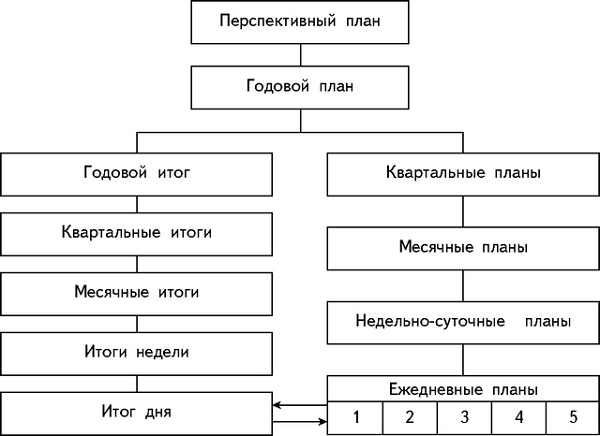14 rules for competent work time planning
Quite often, people, especially businessmen, complain about the lack of free time up to a minute. But if you think about it, the very fact of receiving such a complaint indicates that they were able to carve out time for it. In fact, a person is far from constantly busy, and his perception of his workload and the inability to find even an extra second suggests that his thoughts are not occupied by planning working time. And this is not just a set of beautiful words, but a system of knowledge that can be useful both at the individual level and on the scale of the whole enterprise.
It is no secret that the effectiveness of the organization is not least influenced by the return on the daily work of management personnel. The lack of modern techniques and methods of work, the refusal to improve the individual style of work by the leader and his subordinates lead to the fact that difficulties in establishing the work of such a team become an axiom.
The components that determine how ready a manager is for success are quite simple. These are his skills, abilities, professional knowledge and, of course, personal qualities. Nevertheless, one should not discount the analysis of causal factors that cause problems and difficulties, as well as the desire to overcome them and improve the quality of one's work. Here the rational use of working time by the manager, in other words, its planning, comes to the rescue. After all, it is designed to eliminate the defects of the daily labor process.
The effectiveness of working time planning is based on the goals of activities depending on their duration: short-term and long-term. Such a management framework does not require additional effort, since all identified actions and activities have received their deadlines during the organizing process.
The goals set by the leader have two functions: to determine the actions necessary for their implementation and to stimulate their implementation. When a leader sets himself a clear task, his actions become conscious in its implementation. Goal-setting is a kind of driving force that charges the doer with energy right up to the very achievement of the result.
In order for the planning of the work time balance to be as effective as possible, the manager needs to resort to the tactics of “planning periods” (they can be different time periods: year, month, week, day). The peculiarity lies in the individuality of each such range, which implies the creation of separate plans that would reflect the corresponding time period.
Thus, the main positive focus of proper planning of free time is the gain of time itself. The manager will gain the ability to effectively and fruitfully achieve the described work goals, and at the same time spend as little time as possible. In the organization of individual work, the role of planning is difficult to overestimate: after all, it helps to prepare for the fulfillment of goals and structure the time allotted for work.
Working time planning methods
Pareto principle
Wilfred Pareto (1848–1923) formulated the principle that within a certain group, the objective importance of a certain small part will be much higher than its relative weight in this group. Pareto in his model used the 80/20 formula, which began to be applied everywhere.
- From 20% of the goods sold, you can get 80% of the profit.
- 80% of the remaining goods will bring only 20% of the profit.
- 20% of mistakes cause 80% of losses.
- 80% of other mistakes cause 20% of losses.
This principle has not been bypassed by fans of working time planning. If you project it onto the work of a manager, then the result will be as follows: to achieve 80% of the results, you need to spend only 20% of the working time. The rest of the time spent brings only 20% of the total result.
In the language of the labor process, this would mean that easy and pleasant work, which requires a minimum of effort, but a decent amount of working time, should not be a priority. It is necessary to start activities with maximum consideration of the importance of each task. In the first place of work planning should be vital questions.
For the full implementation of the Pareto principle in matters of rational planning and time tracking, it is necessary to analyze all tasks for the percentage of their contribution to the overall result, and also distribute them by ABC categories.
ABC planning
The basis of ABC analysis is the experience that shows that the proportions of cases of greater and lesser importance are often approximately the same. The letters A, B, and C are used to classify the significance of tasks in relation to the achievement of goals into three classes. This principle appealed to many managers.
You can also use this analysis to plan how you use your working time. The main thing is to remember that you need to allocate working time relative to the importance of tasks, and not their labor intensity and weight in the overall plan of activity.
The ABC analysis comes from experience based on three pillars.
- Category A tasks (most important) receive 15% of the manager's total tasks. Despite their low relative weight in planning, they contribute 65% to the achievement of goals.
- Category B (important) tasks make up approximately 20% of the total tasks, and their importance is also estimated at 20%.
- Tasks of category C (as the least important): they are given about 65% of the total figure, but their importance is negligible - only 15% of the relative weight.
Accordingly, when planning working time, ABC analysis focuses on the initial performance of tasks from category A, since they bring the lion's share of the effectiveness of the final work activity. Next in turn are questions from group B, whose contribution to the final result should not be neglected either. And finally, you can already decide what to do with the remaining tasks of category C: contribute to the planning of your working time or delegate.

- Quadrant 1: Important and Urgent
The heart of the Eisenhower matrix is precisely the first quadrant, since it is fraught with the main secret - it is left empty. This will indicate that a person has the skill of effectively planning working time to achieve goals.
The presence of cases claiming the first quadrant indicates constant hands-on work in the life and work of such a person. Consequently, a person is not accustomed to the distribution of his affairs and duties, but instead delays everything he can until the last moment. And, when the deadlines are running out, he gets to work.
Of course, it is best to prevent possible situations if you think about everything in advance. After all, there is a well-known principle according to which it is always more difficult to eliminate the consequences than to foresee all possible troubles. In case such cases can be performed by other people, they should be transferred.
- Quadrant 2: Important and non-urgent
In planning his working time, Eisenhower determined the tasks from the second quadrant as the most important tasks. If the performer consistently performs the task placed in this quadrant in a timely manner, then he can afford to spend as much time on it as necessary. He will not be haunted by fuss, haste and various negative consequences. This is very similar to a doctor's appointment: just as a preventive ophthalmological examination will prevent more serious vision problems, and the right time to work on the report will avoid urgent overnight processing.
Planning and accounting of working time within the framework of the second quadrant are made in such a way as to achieve the personal goals of the employee.
And although the sword of Damocles does not hang over the workers in the form of the urgency of work, which allows us to focus on the quality of work, we should not forget that there are still deadlines, and they need to be monitored, since failure to complete the task of the second quadrant automatically transfers it to the first. And this outcome is fraught with consequences for planning personal time.
- Quadrant 3: Urgent and not important
The type of cases corresponding to the third quadrant does not allow you to focus on more important matters because of its urgency. And such cases are easily confused with cases from the first quadrant. However, it is worth drawing a line between urgent and important, since these concepts are not synonymous. There is a simple way to determine this: you need to ask yourself whether this or that task brings you closer to the fulfillment of a given goal. Usually cases from the third quadrant receive a negative answer.
Most often, household issues are brought into this quadrant: dry cleaning of clothes at the end of the season, helping neighbors in an urgent matter, unimportant meetings and negotiations. There is another example - computer repair, but here you should be extremely careful: if this equipment is needed for work, then its repair will become a task of paramount importance (that is, the first quadrant), and if it is used only for entertainment, then the very place of this problem is in the third quadrant.
The affairs of this quadrant not only do not fit into the planning of working time, but even distract from the main goals and take away valuable time. It is best to ignore them if possible. How to determine the importance of a task for yourself? Very simple. You should ask yourself the question: “What will happen if I don’t do this?”
- Quadrant 4: Not Important and Not Urgent
This category includes the affairs of our everyday life that have nothing to do with work: social networks, forums, surfing the Internet, computer games, watching TV shows. Yes, such an activity is definitely enjoyable, but it is not mandatory.
In general, this activity significantly reduces the productivity of the working day, Eisenhower called the cases from this category "devourers of personal time."
Take, for example, a series lasting 200 hours - in terms of recalculation, you get a whole week of wasted time, which could have been used with much greater benefit.
Therefore, it is necessary to identify your personal eaters and strive for tight control over them by planning not only work, but also personal time.
There are also routine things in this quadrant that are not so pleasant for many: for example, washing dishes, cleaning, cooking. Here, too, it is worth looking for a compromise with those people with whom you live in the same house, in order to plan a uniform load.
Work time planning table
Here is a simple example in the form of a table.
|
Tuesday |
Subtask |
Comment |
|
|
Check to-do list |
|||
|
commute to work |
|||
|
Phone calls |
Retrieve two contact numbers from work email |
||
|
Article writing |
Material Analysis |
||
|
Article writing |
Translation of additional materials from a foreign language and typing of the main text |
Do not forget to issue footnotes to the sources and correct the hyphens on the dash |
|
|
Go to the editor |
|||
|
meeting |
|||
|
Wednesday |
This example clearly demonstrates the principle of building work plans. If necessary, tables can be of greater depth, with extended space for notes. It does not matter what program will be used to implement, say, an individual planning the working time of the manager/specialist. Table - the tool is universal, it can be drawn even on plain paper. What is really important is to be able to adapt it for yourself, your tasks and goals, and determine for what time intervals it will be used: by days, weeks, months.
How is the planning of the working time fund
The initial stage of planning is to analyze the initial parameters of the system - the presence of activity to improve the working time fund (FW) and its directions. Then follows the answer to the questions: who is responsible for this activity (specialists, services) and its planning? To what extent are working hours taken into account? Is time spent being monitored? Are FRV reserves disclosed? Are measures taken to reduce the loss of working time at the planning stage? What methods are used for this?
The next stage is the analysis of the application of the PDF. Within its framework, they study the dynamics of the production of workers (with reference to time - hourly, daily, annual) and identify the factors influencing it; analyze the state of the PDF and determine unused opportunities to reduce certain types of absenteeism; work out observational data on the operation of the working time fund, etc. More details on the methods for analyzing the use of the working time fund can be found in the educational and methodological literature.
The information base for the analysis of the PDF is the data of statistical and time records of working hours; a summary of the primary accounting (a leaflet on idle time, overtime employment, on the elimination of marriage); self-photographs and photographs of working hours; survey and questionnaire data.
In the course of the analysis, the use of the entire PDF and its constituent parts - full-day and intra-shift funds within the framework of various levels of the enterprise (structural divisions, the enterprise as a whole, professions and groups) is examined. This approach makes it possible to detect "bottlenecks" that should be given attention in the first place. The result of the analysis is an assessment of the reserves for improving the use of the PDF and, accordingly, increasing the efficiency of working time planning.
The results obtained are used to plan a useful fund of working time. This event includes the preparation of a planned balance budget, a comparison of its components with the norms of the enterprise, as well as saving working time for unproductive costs. Methods for distributing the balance of working time have received adequate coverage in educational materials and manuals.
Planning and analysis of working time have acquired specific features in a market economy. For example, compulsory administrative leave is beneficial for the enterprise in terms of its costs. Part-time work has lost its reserve status.
A differentiated approach for permanent full-time employees, temporary workers becomes relevant in the planning of the ECF; in part-time employment.
For the purpose of the most effective organization and planning of working time at the enterprise, special measures are taken: socio-economic, organizational and technical, and therapeutic and prophylactic. They are reflected in various organizational and technical plans, planning for the improvement of working conditions, etc. The involvement of external participants should be discussed with local authorities and only then be included in activity planning. Any event must be resource-provided.
How to properly plan your work time
Rule 1. Get up at the same time
This initial stage of any planning is very disciplined and energizing.
Rule 2. Positive mood at the beginning of the day
Work on your mood every morning, because it greatly affects the solution of tasks to achieve goals. To do this, you can ask yourself three questions:
- How will “today” bring me closer to success?
- What should I do to make today as much joy as possible?
- What should be done on this day to maintain your health?
The answer to these questions and the creation of positive motivation often do not exceed two minutes. Give them to yourself before starting your standard morning activity.
Rule 3
The key to a harmonious morning is a good night's sleep and a good breakfast. But many donate them, excused by the lack of time. However, both missions only require prioritization at the planning stage of the daily routine - in essence, you just need to allocate your time in such a way that you go to bed early.
Rule 4: Consider Factors Like Fatigue When Planning Your Workday
Many people feel that their work productivity fluctuates like a sine wave all day long. This does not depend on daily biorhythms - on whether you are a “lark” or an “owl”. It is worth finding out your personal periods of activity rise and place the most important things for this daily interval in the activity planning. It is better to devote the afternoon to daily routine work that is not of particular importance.
Rule 5. Take breaks on time
One of the basic rules for planning working time is a short rest, as it allows the body to recuperate and return attention to work. Be sure to take short breaks in work, set the duration and frequency yourself. Remember regularity.
Rule 6
Try not to jump in work and bring the work you have started to its logical conclusion. Do not get distracted by smaller things, because they steal work time. Remember that, each time returning to the work already started, you will have to repeat the old actions, and this will affect the balance of personal activity planning.
Rule 7
Strive to fill all the unaccounted for gaps in your schedule (waiting in line, uninformative meeting) with useful activities. Define its essence for yourself by asking yourself the question: “How can I fill these minutes in order to get the maximum benefit?”
Rule 8: Stick to the 70/30 principle
You only need to log 70% of your working time in your diary. Otherwise, even if you schedule your working day 100%, you will not receive guarantees that all tasks will be completed, even more: many actions will not coincide with the schedule. The purpose of planning working time according to this principle is to save the nervous system from overload, to prevent feeling like a machine and confinement to a rigid framework.
Rule 9. In the evening, make a plan for tomorrow
Do your planning for tomorrow at the end of today and do it in the form of a written list so you don't miss anything. It is better to establish the importance of cases in advance and distribute them in columns. This will make it possible to focus on the necessary tasks, and less significant ones can be moved in case of force majeure.
Rule 10
An immutable rule for everyone. The more often you can find time for rest, the more productive you will work later. During this period, you can put things in order at the workplace, in the house, wash the dishes, read a magazine or a book, take a walk in the fresh air, help others. If you can't do it spontaneously, plan those actions too.
Rule 11. Be realistic about your abilities
Do not overwhelm yourself with a huge amount of work, believing that you can handle any mountains. Approach soberly to the assessment of your own strengths and take better what you are guaranteed to cope with in a day / week / month, such planning of working time will be more effective.
Rule 12
This approach to items on the table and in the office helps save time in the future. Make it a rule, having used a thing, return it to where you took it. Set specific places for different types of things - a folder for papers, a pencil case, a desk drawer or a check box.
Rule 13. Lead an active and healthy lifestyle
It would seem, why do office workers need sports, yoga, fitness, proper nutrition, gymnastics? Then, that a healthy body and well-being are best tuned to positive energy and readiness for highly productive work activity, especially after its quality planning.
Rule 14
The best way to self-organize in the planning and implementation of professional activities is to experience a sense of satisfaction and love for your work. Its advantage is that motivation does not have to be pulled out with tongs, it comes by itself and in large volumes.
Planning and organizing the working time of the head
Tip 1. Review plans for the day
To do this, you can use the ABC analysis or the Eisenhower matrix. Even a ten-minute preparation for a work day can save up to two hours a day. Make good use of them.
Tip 2. Formation of blocks of similar cases
A constantly distracted person needs significantly more time to work than a focused and enthusiastic person. This is due to the need for another “run-up” and “immersion”, that is, a return to labor activity. Blocks of the same type of tasks will help save working time: they are easier to fix at the stage of activity planning.
Tip 3: Make time for yourself at work
Often, visitors, subordinates or clients on the phone distract from direct duties. All of them create strong interference in the performance of really important tasks, disrupt the balance of working time. In this regard, it is impossible to be available to everyone and everyone throughout the working day - both in your office and over the phone. In the process of scheduling working hours, masters of their craft organize gaps for themselves when no one will disturb them. You can also use their tools, for example, set the hours for receiving visitors, use an answering machine.
Tip 4: Set aside limited time for each work task
The duration of a certain type of work is directly dependent on the time available. Even the smallest task is subject to planning: learn to give the task exactly as much time as it takes to complete it. For example, business negotiations should not be delayed, you should discuss all the issues of interest as much as possible, but not more than an hour. This can be done with the help of strict time frames and regulations. Be guided by a simple rule: "Time is money", appreciate and save them.
Tip 5: Use Delegation
No time-respecting actor should do all the tasks on his own. This approach has already been described in the principles and rules of working time planning: everything that can be delegated to other people (65% of tasks that consume time and effort, but do not bring significant results) should be delegated to them. This applies not only to the assistance of employees, but also to the use of assistance from third-party agencies, organizations, consulting firms.
Tip 6. Break large tasks into components
People tend to evade large or voluminous tasks, in every possible way to delay their implementation, because the result seems too far away for them. This fact indicates weak personal time planning skills, but it can be circumvented. Cases that give the fastest results are liked by almost everyone. This was noticed by Albert Einstein on the example of chopping wood. The same can be done with long-term goals and large projects: break them down into small tasks, plan them, and then methodically complete them over a period of time (for example, two hours a day). After, say, a week, the first results will appear - the goal of the first part of the project will be achieved (according to planning), this will give strength and motivation to continue working in this direction.
Tip 7. Set personal deadlines for priority tasks
When you know in advance which cases will be priority for the current month, they can be noted in the working calendar and taken into account in personal planning along with the same negotiations / meetings. Thus, when it becomes necessary to make another event or action for this date, it will already be “booked”, which once again reminds you of the objective significance of the task. This advice is of particular value in the matter of planning work activities.
Tip 8. Organize your workspace properly
First of all, it concerns the order on the desktop. Only those documents should be left on it, without which it is impossible to do the tasks of category A. This action has a psychological background: order on the table helps order in thoughts, and extra papers take time.
Tip 9. Try not to let others put additional responsibilities on you
Often leaders are interested and engaged in new things, expanding their areas of competence. Coming out of personal interest to meetings that an employee does not usually attend, he can get into work groups or receive additional tasks that are not included in his plan and, as a result, become a burden on the main work and its planning. It is best to double-check all your actions for their relevance within the position, thereby improving your time planning skills.
Tip 10. Assess how important and urgent the things in which they suddenly want to involve you are.
Force majeure and other urgent matters are a common occurrence for any firm or enterprise, even if they strive to operate within the framework of strict planning. To solve them, all available resources are mobilized. If you agree to help out in this situation, remember that this will take time away from the current important tasks in your schedule, so always weigh whether they are worth sacrificing.
Tip 11 Don't act on impulse - make smart decisions
Sometimes certain decisions are made as a result of an impulse, an uncontrollable impulse. But this provokes deviations in the schedule and interferes with the effective planning of working hours to achieve the goal. If you feel a momentary desire to do something (for example, call), carefully consider and weigh whether it is really worth doing what you have planned.
Tip 12. Set your priorities right
In a large flow of cases - conferences, meetings, calls, texts - it can be very difficult to navigate, and when you take on everything at once or grab it in parts from different ends, you end up with very little time. Here it is useful to recall such a way of planning time as a matrix of priorities, and start with the implementation of clearly defined and unambiguously significant tasks, gradually moving towards less important ones.
Planning the working time of the secretary of the head
The main duty and purpose of planning the individual working time of the secretary is to relieve the boss as much as possible and help him allocate his time. It is the task of increasing the efficiency of using all possible hours and minutes for labor activity. And this means that the tasks and planning of the activities of the head and the secretary are interdependent.
First of all, the secretary helps in organizational, preparatory and managerial types of work, frees up space for creativity for the boss. To this end, the assistant needs to know the daily routine of the higher level, the schedule of his tasks for all possible periods - day / month / quarter. Effective planning of the secretary's working time depends on the schedule of his immediate supervisor, since he is preparing all meetings, negotiations and other matters (reception of visitors, paperwork) that are in the boss's schedule. A key role in planning is played by the hierarchy of tasks according to their value and importance.
In addition, the duties of the secretary also include other work that does not depend on the regime of the day of the boss (and is reflected in the planning of labor activity): this is checking mail and answering correspondence, document management, a control file, etc. The assistant's time planning skills must be on top. The starting points of his schedule are always repetitive activities, for example:
- prepare the workplace of the head;
- tidy up your own workplace;
- handle all types of incoming emails;
- view the control file;
- provide the authorities with a summary of the state of affairs and clarify the schedule for the current day.
Consider a simple example of working time planning in relation to the manager's schedule. The secretary's program of action will look something like this. When the boss plans a meeting at 11:00, then the assistant’s plan at 10:30 will mark his organization with all the ensuing actions: reminder, photocopying of materials, cleaning the conference room, logging. If at 14:00 the manager planned negotiations outside the office, then the secretary's schedule will include items on calling a car and collecting documents. Also, the list of works indicates with whom and at what time you need to connect the boss for a telephone conversation, what documentation needs to be corrected, and what to fill out from scratch, etc.
The best option is to determine, together with the boss, a constant time interval for daily activities: signing documents, receiving visitors. This will improve the work and help plan the working time of both the specialist and his assistant. When developing a work schedule, you also need to leave a decent reserve in case of sudden urgent and important assignments, phone calls and other emergencies.
The secretary dedicates the end of the working day to sending outgoing correspondence, and also plans events for tomorrow.
When the working day is over, and the manager is late in the office, the assistant can go home only if there is an appropriate agreement between them and he provides the boss with all the necessary data.
Before leaving the premises, the secretary removes all documents, closes cabinets, safes, turns off electronic equipment (this does not apply to telephone, modem, fax), puts the workplace in order.
Manager's time scheduling
The essence of planning is preparation for the implementation of goals and the regulation of working time. The principles of planning the manager's working time do not differ much from the general principles of labor regulation. Rational use of your time resources involves understanding your functions, goals, objectives and time budget.
In the process of organizing the working time of a specialist, widely known planning techniques are used. The manager needs to be guided by the following rules:
- 60% of the daily work plan is allocated to scheduled work;
- 20% of the time - for unforeseen actions;
- the last 20% is best left for spontaneous tasks.
"Flat" organizational structures are used in small enterprises to solve complex problems in conditions of significant uncertainty. Such divisions are characterized by the following disadvantages: excessive workload of managers, difficulty in controlling the actions of a large number of people, as well as difficulties associated with coordinating the work of divisions.

The time spent (especially if it is not noted at the planning stage) should be recorded with a mandatory indication of what and how it was used. This contributes to the fact that, having received a complete picture of the costs of his working time, the manager will be able to more effectively organize his planning in the future; in order to develop a quality plan, the tasks will be divided into short, medium and long-term.
Regularity, consistency and consistency should be positioned as the main principles of planning. It is necessary to follow one of the important principles of activity planning - the reality of goals: to take on as many responsibilities as it will be possible to fulfill.
At the heart of the rational expenditure of the manager's working time is his long-term plan. This is a multi-year system, taking into account which annual and quarterly plans are created. The latter can be coordinated with the annual and be divided into monthly. Daily and weekly plans fully correspond to them and at the same time most accurately reflect the use of the manager's working time. Planning work activities at the level of one day is an important step in the overall planning of the manager's work activities, it is subject to constant monitoring and adjustment depending on the situation.





